Armand
Continued onto: Armand (post 1930)
The Armand Company founded by Carl Weeks was best known for its Cold Cream Powder. By 1927, it had become a leading seller of face powder in America with revenues of US$2.5 million and an annual income exceeding that of either Elizabeth Arden or Helena Rubinstein at that time.
Carl Weeks
Carl Weeks was the son of Charles Weeks [1838-1912] and Laura Weeks [1843-1925] (née Chamberlain), the sixth child in a family of eight children. Born in Toddville, Linn County, Iowa in 1876, the family moved to Jewell County, Kansas in 1878 where they operated a sheep ranch. They later relocated to Plainville, Rooks County where they ran the Old Sod Hotel and a general store (Harlan, 1931, p. 109).
In 1888, the family returned to Iowa and settled in Des Moines where Carl, aged 12, got a job in a drug store while studying at night. He later enrolled at the Highland Park College of Pharmacy in Des Moines receiving his pharmaceutical certification from the Iowa Board of Pharmacy in 1893.
Following his certification, Weeks moved to Oskaloosa, Iowa where he worked for the Green & Bentley Drug Company. After working for Green & Bentley for a number of years, Weeks decided to start his own business and purchased a drug store at 116 East Jackson Street, Centerville, Iowa in 1900 (Harlan, 1931, p. 110).
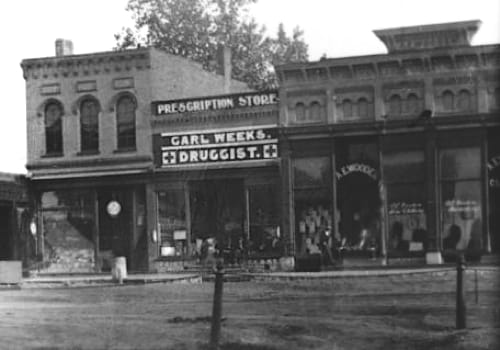
Above: c.1900 Carl Weeks Druggist. Red Cross Prescription Store in Centerville, Iowa purchased from J. H. Udell.
Unfortunately, things did not go well. Weeks came down with tonsillitis which was treated surgically when the condition was incorrectly diagnosed as tuberculosis of the glands. After spending some time in Utah recovering from the operation, he came back to Centerfield and sold his pharmacy business to Alexander Jones Weller [1873-1932] in 1902.
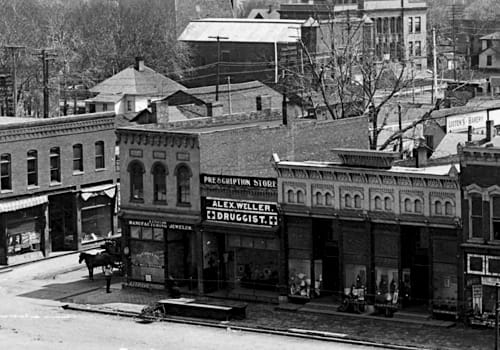
Above: c.1902 Alex Weller Druggist. Red Cross Prescription Store in Centerville, Iowa.
Following the sale, Weeks returned to Des Moines and became the secretary and treasurer of D. Weeks & Company, a business started by his older brother Deyet to manufacture proprietary medicines.
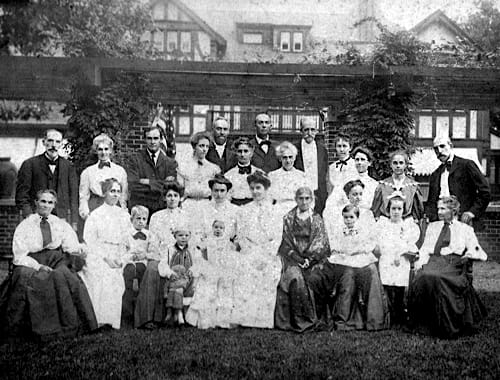
Above: c.1905 Carl Weeks (third from the left in the back row) and his extended family.
It was in Des Moines that Weeks met Edith Van Slyke and, in the period leading up to their marriage in 1907, he visited her in Paris where she was studying art and this when he later claimed to have developed an interest in face powders.
In 1907, Weeks established the Florian Company at 115 West South Second Street, Des Moines. It was listed in the city directory as a medicinal manufacturer with Carl Weeks as its president. A number of biographers suggest that it manufactured a face powder developed by Weeks.
When Deyet Weeks died in 1908, Weeks and his younger brother Leo took over the D. Weeks Company and founded D. C. Leo & Company. The additional workload may have been the reason why Weeks sold his Florian company in 1909.
If Weeks did develop a face powder while he owned Florian then it languished until January, 1915 when D. C. Leo & Co. began informing druggists that they could now supply them with face powders. The first sales are said to have been made to Joe Kinney, a druggist of Logansport, Indiana.
When there was interest in the face powders, Carl and Leo Weeks founded the Armand Company in December, 1915, incorporated in 1918 (capital US$10,000), to manufacture and distribute them. Carl Weeks was made the president of the new company with Leo Weeks taking on the roles of vice-president, secretary and treasurer.
Armand Complexion Powder
Carl Weeks always claimed that the idea for his Cold Cream Powder came when he was visiting Edith Van Slyke in Paris. However, it is worth noting that the face powder Weeks developed in 1915 was not made with cold cream. Originally called Armand’s Perfect Complexion Powder, it became Armand’s Complexion Powder by 1916. The ‘Perfect’ name may have been dropped due its use by Daggett & Ramdsell for their Perfect Cold Cream.
Armand’s Complexion Powder:
Made by a chemist whose first care has been for the needs of the skin. Contains no rice powder to enlarge the pores, no chalk to injure the eyes, no lead, which is always dangerous. So pure, so fine and soft that in many homes it is used instead of talcum powder, even in the nursery.
Armand’s protects the skin, is entirely invisible, clings persistently, is a true beautifier, White, Cream, Pink, Brunette or Tint Natural, in odours of the utmost refinement.
In the paper box at 50 cents, or silk box at &1.00 to $10.00(Armand advertisement, 1916)
Also see: Daggett & Ramsdell
When interest in the face powder became evident, Weeks engaged the services of the N. W. Ayer & Sons advertising agency. It was this company that developed the iconic red and white check, blue stripe plaid pattern powder box, topped with a Louis XVI silhouette medallion that first appeared on May 29, 1916.
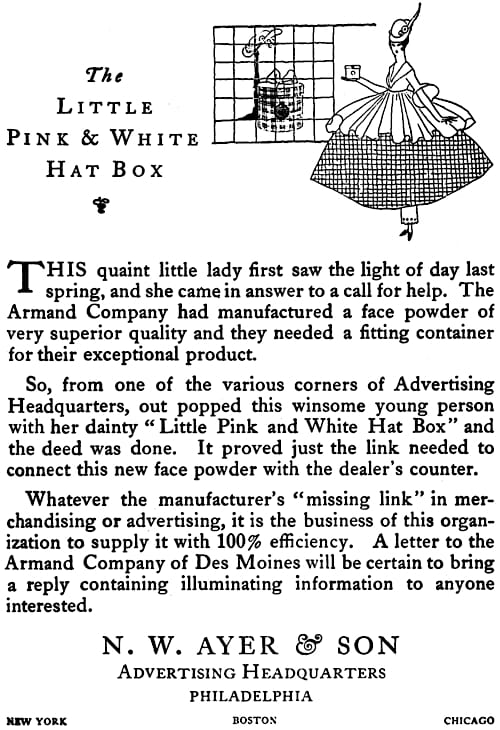
Above: 1917 Trade advertisement for N. W. Ayer & Sons.
Armand Complexion Powder could be used as a loose face powder but could also be mixed with water and applied as a liquid face powder for evening use. It came in a number of fragrances – Violet, Rose, Bouquet of Paradise, and Azotea with prices varying depending on their fragrance used. Cheaper powders came in cardboard containers while more expensive powders were sold in hand-made silk boxes.
Armand Cold Cream Powder
The first Armand face powder containing cold cream did not appear until 1918 when Armand added Amabelle and Aida Complexion Powders to the range. Amabelle was a lighter powder scented with Amabelle fragrance and was packaged in an oval box. Aida contained a small amount of cold cream and was sold in a round ‘hat’ box. It was presented as an ‘ideal powder for those who are much out of doors’ for ‘motorists, tourists, golfers etc.’. Both powders came in the same five shades as earlier Armand Complexion Powders – White, Cream, Pink, Brunette, and Tint Natural.
Armand Bouquet Powder (Square Box): “[A] medium dense powder deliciously perfumed and exquisitely fine.”
Armand Amabelle Powder (Oval Box): “A lighter powder, for those who have been accustomed to using a light or rice powder.”
Armand Aida Powder (Round Hat Box): “A Cold Cream or out-of-door powder, contains sufficient cold cream to alter the texture and character, making it very dense and extra adherent.”
Armand Roses of Paradise Powder (Square Hat Box): “Faithfully reproduces the fragrant perfume of fresh roses.”
Adding cold cream to a face powder meant that Aida Powder was a type of fettpuder (fat powder) with improved skin adherence. Like other powders, it was applied with a puff but Armand later recommended the following technique for best results:
In order that it may cover the skin with a smooth, even film, you must first rub Cold Cream Powder into the puff. To do this, put the powder on the puff, fold over the puff, and rub it against yourself, before blending the powder onto the skin. Because it is so fine and dense and covers the skin so well you can do this with Armand Cold Cream Powder. It is the very minute amount of cold cream in Armand Cold Cream Powder that makes it different from other powders, giving it a density with produces extra smoothness of finish and makes it certain to stay on.
(The Armand Company, 1929, p. 31)
See also: Fettpuders (Fat Powders)
Between 1918 and 1920, Armand began to drop the Aida name in preference for Armand Cold Cream Powder. It became Armand’s leading line by 1920, advertised as the ‘first and only dry face powder that contained cold cream’. This was not the case and it led to an unusual decision by the company that involved a patent.
In 1926, Armand advertised that its Cold Cream Powder was produced under patent no. 1,332,190 filed in June, 1918. However, this patent was submitted by Meda Vay Hull [1871-1943] not Carl Weeks and was assigned to the La Meda Manufacturing Company who made La Meda Cold Creamed Powder. This other cold cream powder first appeared in 1918 and remained on the market through the 1920s.
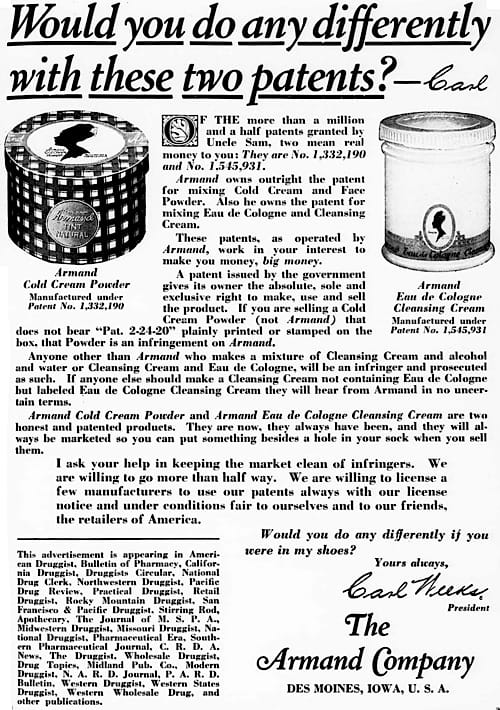
Above: 1926 Armand Cold Cream Powder [Patent No. 1,332,190] and Armand Eau de Cologne Cleansing Cream [Patent No. 1,545,931].
Armand’s Aida Cold Cream Powder was available by April, 1918, at the latest, which is before Meda Vay Hull filed for her patent. This suggests that Carl Weeks came up with the idea of adding cold cream to face powder independently of Meda Vay Hull but decided to license the idea because of her patent. Why he did this I do not know. Whatever the reason, it must have been irritating and may have convinced Carl Weeks to patent his Eau de Cologne Cleansing Cream formulation in 1925 to avoid a similar situation.
The Armand Company
Before Armand moved to 124 Des Moines Street, Des Moines Armand Complexion Powders were made by D. C. Leo & Co.
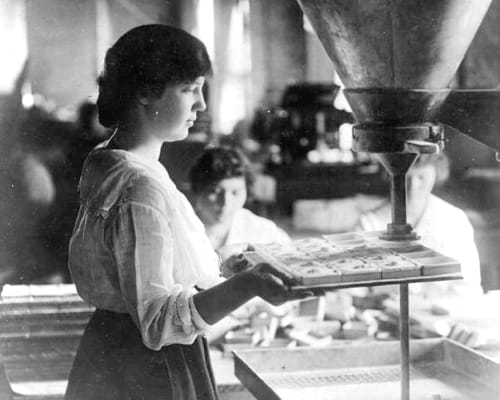
Above: 1916 D. C. Leo & Company. A woman appears to be filling boxes with powder, possibly with Armand Complexion Powder.
After Weeks engaged N. W. Ayer & Sons to create a national advertising campaign for Armand products, sales expanded rapidly. By 1920, the company was selling Armand Complexion Powders through drug stores, pharmacies and chemists as far away as Australia. Armand subsidiaries were also established outside of the United States starting with Armand Ltd. in St. Thomas, Ontario, Canada in 1920; then Florian and Armand Ltd. in Queensway, Ponders End, Middlesex, England (1922); Florian et Armand at 20 Rue de Paix, Paris (1923); and Armand de Mexico in Mexico City (1926). Agents were also developed in Buenos Aires, Argentina, and Sydney, Australia.

Above: 1925 Armand plant at 124 Des Moines Street, Des Moines.
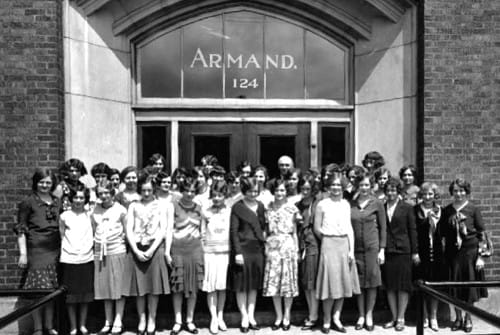
Above: 1925 Workers outside the Armand factory and offices. Carl Weeks is standing in the background.
Although advertising brought Armand powders to people’s attention, the company’s remarkable early growth was largely built on its close relationships with small drug stores. Early trade promotions for Armand Complexion Powders capitalised on his association with “D. Weeks & Co., 20 years square dealing and fair prices, and D. C. Leo & Co., 15 friendly years with the Drug Trade”.
Having worked in drug stores, Weeks was well aware of the pressures that small-time operators were under, particularly from competition from the growing number of chain stores that used economies of scale to sell products at lower prices.
As well as providing druggists with display and sales advice, Weeks set fixed prices for his goods, did not offer discounts for large orders, vigorously discouraged price-cutting by stopping supplies to anyone that did and did not sell to general stores in towns where drugstores stocked his line. Even in the difficult years of the 1930s, about ninety percent of Armand’s total sales remained with wholesale and retail druggists, with less than ten percent going to department stores in large cities, general merchants in small towns without a druggist, and large mail-order houses.
Some of Armand’s business principles were laid down in the Armand Merchandising Policy, first advertised in 1919. Initially, stores that bought Armand products were asked to give written declarations that they intended to comply with the policy but Armand abandoned this practice in 1922.
The Armand Merchandising Policy
1. The Armand business is founded and built upon two fundamental principles, to wit: first, highest attainable quality of product, and second, absolute and unquestioned fairness and justice in all relations with customers, both trade and consumer.
2. In the interests of fairness and justice to all concerned, The Armand Company suggests fair retail prices for Armand products and declines to sell to dealers who do not charge them. Likewise, the Company declines to sell to dealers, who effect any other unfair trade practice in merchandising Armand products. Sales once made are, however, absolute and unconditional.(Armand Merchandising Policy, 1922)
These measures helped smaller operators maintain their margins and undoubtedly convinced many druggists in small provincial towns across the United States to sell Armand cosmetics in preference to other brands.
Weeks also supported organisations that druggists belonged to. He was a Freemason and a Shriner, joined Rotary in 1914 and advertised extensively in ‘The Rotarian’. Armand also advertised in medical trade journals and exhibited its products at medical conventions.
Weeks also made use of the new medium of radio. In 1928, the company was advertising Armand cosmetics through ‘The Armand Hour’ featuring Mademoiselle Armand and the Armand Girls broadcast across America in cities that included Tulsa, Oklahoma City, Chicago, Omaha, St. Louis, and Dallas.
Products
New make-up and skin-care lines that followed the introduction of Aida Cold Cream Powder in 1918 included: Armand Cold Cream Rouge (1919); Armand Cold Cream Talcum Powder (1920); and Armand Cold Cream, and Armand Vanishing Cream (1921). Other lines added during the 1920s included: KXY nail polish (1923), a nail polishing powder developed in France by Savoly; Handola (1926), a hand cream based on a vanishing cream formulation; Mimosa, a soap; Cleanodore (1928), a liquid and powder deodorant; and Noroma, a stick deodorant (1929).

Above: Armand Savoly KXY nail polishing powder.
Skin-care
Like others of their type, Armand Cold Cream was used as a skin cleanser and night cream, while Armand Vanishing Cream served as powder base and daytime skin protectant.
Cold Cream: “Removes impurities from the pores which soap cannot reach. Leaves the skin non-oily.”
Vanishing Cream: “Protects the pores from dust, wind or sun. Forms a velvety base for face powder.”
In 1925, the company began selling Armand Eau de Cologne Cleansing Cream which included enough alcohol to make the cream slightly astringent. Carle Weeks patented the formulation perhaps, as previously mentioned, to avoid the problems he had experienced with Armand Cold Cream. By 1929, Armand had added two other cosmetics that contained an astringent – Armand Eau de Cologne Astringent and Armand Skin and Tissue Cream. Armand Eau de Cologne Astringent contained eau de Cologne and witch hazel while the Skin and Tissue Cream was formulated with camphor to give it astringent and healing properties.
Eau de Cologne Cleansing Cream: “In the jar, a fragrant cream … On the skin, a liquefying, penetrating oil … to be left on a few minutes and then removed with facial tissue. Cleanses, softens and refreshes.”
Eau de Cologne Astringent: “Mild and refreshing.”
Skin and Tissue Cream: “A camphorated night massage cream which softens and beautifies, refines the skin band discourages fine lines and wrinkles. Acts marvellously in overcoming blemishes.”
After Carl Weeks came to the strange conclusion that vanishing creams were unsuitable as foundations he introduced Armand Foundation Creme in 1927.
Many creams of the vanishing type are called foundation creams by their makers. But because face powder will not spread smoothly and evenly on vanishing creams they are not recommended for powder base. …
A correct foundation cream consists of a combination of fine oils such that when the cream is applied to the face a small amount of it clings to the surface of the skin.(The Armand Company, 1935, p. 11)
Armand Foundation Creme contained a combination of fine oils which meant that it had to be used like a cold cream. Usage instructions recommended leaving it on the skin for a few seconds after it was applied to give the oil time to penetrate and then removing any excess before powdering.
Foundation Creme: “A wonderful powder base which tones the skin and causes the powder to cling indefinitely.”
Make-up
Starting with a compressed powder rouge in 1919, Armand expanded its make-up range during the 1920s to included dry and paste rouges, and lipsticks. However, as far as I can tell, the company did not venture into eye make-up.
Face Powders
Armand Cold Cream Powder, and Bouquet Powder remained Armand’s most popular powders of the 1920s. Some new face powders were introduced early in the decade – Rose Powder, Amette Powder (1921), and Peridore Powder (1923) – but the powder range appears to have been reduced to Armand Cold Cream Powder, Bouquet Powder, Peridore Powder and Rose Powder by 1924. This situation remained until the late 1920s when the company introduced Lady ‘K’ Powder, presumably scented with Beau K fragrance.
Rose Powder: “This is also a Cold Cream Powder, with an intensified door made from crushed rose hearts from the sunny fields of southern France. It contains the true fragrance of fresh cut roses … In new hexagon box with blue-ribboned cover.”
Peridore Powder: “A light weight Powder; does not contain Cold Cream. A pleasing and satisfying surprise for those who prefer a light Powder. It is fluffed to produce a delightful lightness and yet retains the splendid covering quality of a heavier Powder. Round pink-and-white box.”
Armand also added a refillable Armand Cold Cream Powder Compacte in 1921. By 1924, these were being produced as single compacts in gold or oxidised silver as well as double compacts which combined powder with rouge.
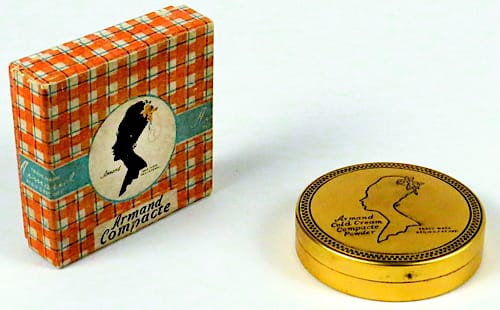
Above: Armand Cold Cream Powder Compacte (Smithsonian).
Cold Cream Powder Compacte: “[I]n its beautiful gold lacquered box has the dame Cold Cream base and delightful fragrance as the Cold Cream Powder. Ideal size for the purse with individual puff and mirror. Double or Twin Compacts containing Compacte Cold Cream Powder and Compacte Rouge … also oxidised Silver Compacte, very light and smart.”
All the Armand face powders only came in White, Cream, Pink, Brunette, and Tint Natural shades until 1922 when Armand Flame (Double Brunette) was introduced. I do not know of any other new shades until Brunatural, Zanzibar, Starlight, and Gitana were added by 1929.
Rouge and lipstick
Armand Cold Cream Rouge (1919) was a compressed powder rouge originally produced in Light and Medium shades. By 1926, Armand had also added a paste/cream Lip and Cheek Rouge, as well as a Cold Cream Lipstick produced in push-up and twist-up cases by the end of the decade.
Cold Cream Rouge: “[I]n tints exclusively Armand, blend perfectly into the tones of the skin and give the complexion a delicate glowing appearance.” Shades: Light, and Medium. Additional shades included Dark; Cheree; Glory of the Morn, and No. 18; which I have been unable to dated but were available by 1927 as well as Armand Flame (1922); Dahlia Pink, and Dahlia Red (1925); and Zanzibar, and After Glow (1928).
Armand Lip and Cheek Rouge: “With a tiny touch of cream you can spread it on evenly and it will last all day.” Shades: Dahlia Pink, and Dahlia Red.
Cold Cream Lipstick: “Protects the lips from chapping and add, just a touch of warm, glowing color.” Shades: Light, Medium, Dark, and Armand Flame with Zanzibar, After Glow, and Starlight added in 1928.
As salon culture gained strength through the 1920s, the company also developed some rudimentary skin-care routines . These included morning and evening treatment planas well as suggestions for common skin problems like blackheads, wrinkles and dry skin.
Morning Treatment
Cleanse: Splash cold water on the eyes and then apply Armand Eau du Cologne Cleansing Cream to open pores and remove excess oil. Remove with a soft cloth or facial tissue.
Close pores: Use Armand Eau de Cologne Astringent to close pores and help prevent wrinkling and sagging.
Prepare skin for powder: Apply Armand Foundation Creme to soften and refine skin and help powder to cling. Remove with a soft cloth or facial tissue.
Apply powder: Apply Armand Cold Cream Powder in the tint that matches the skin.
Apply Rouge: If using a dry rouge apply after powder; if a cream rouge apply after Foundation Creme and then follow with powder.
Night Treatment
Cleansing: Apply Armand Eau du Cologne Cleansing Cream and then remove with a soft cloth or facial tissue.
Firming: Use Armand Eau de Cologne Astringent to close pores and remove impurities.
Massaging: Pat Armand Skin and Tissue Cream or Armand Cold Cream into the skin on alternate night. Use depends on skin type.
Special Treatments
Blackheads: Use Armand Skin and Tissue Cream to soften the blackhead and Armand Eau du Cologne Cleansing Cream to remove. The Night Treatment helps eliminate blackheads and enlarged pores.
Dry Skin: Cleanse with Armand Eau du Cologne Cleansing Cream and use Armand Skin and Tissue Cream or Armand Cold Cream in the Night Treatment. Use Armand Eau de Cologne Astringent to refine pores and Armand Foundation Creme as a powder base.
Wrinkles: Use Armand Skin and Tissue Cream to soften rough skin and reduce wrinkles.(Modified from The Armand Company, 1929)
Armand suggested a light touch when massaging its Skin and Tissue or Cold Cream into the skin, as a heavy hand could generate wrinkles and develop facial hollows.
Use a light circling motion, touch in the skin firmly but ever so gently. Never pull it or draw it. (That stretches the skin and makes wrinkles.) Never rub or press hard. (That breaks down the fat cells and causes hollows and flabbiness.)
(The Armand Company, 1927, p. 9)
In 1930, Weeks submitted a trademark for Pit Patter which suggests that he may have later preferred using a patter.
Also see: How do I look? (1927)
Colour coordination
Generally speaking Armand make-up was colour coordinated against two main types – blondes and brunettes. In 1929, Armand came up with a more comprehensive scheme which was outlined in its ‘Find Yourself’ booklet available free with any dollar purchase of Armand products.
Written by a psychologist and a noted beauty expert, the ‘Find Yourself’ booklet used a questionnaire to get women to analyse their appearance and personality. Armand made shade recommendations for some of the eight personality types but most of the references to make-up were related to how it was applied not for what shade to use. These results were summarised in a chart in the centre of the booklet.

Above: 1929 Armand personality types
See also: Make-up, Personality and Types and the Armand company booklet: Find Yourself
Florian, Inc.
In 1922, Carl Weeks bought back the Florian Company he had sold in 1909. Three years later he created Florian Face Powder for men. Male face powders were not an uncommon product of the time and were used to kill shine and help disguise beard growth during the day.
After experimenting with a number of other men’s toiletries, Weeks then began introducing his Mascu-line range of men’s toiletries in 1928, starting with Brisk, a mint julep shaving cream. In the 1940s, Brisk was advertised as containing Tritanol, another name for triethanolamine, and lanolin. This suggests that it was a stearate shaving cream of a type that is still made today.
Brisk was followed by Stip, a styptic, Zest, a bracing after-shave lotion, and Trim, a hair dressing in stick form and the original Florian Face Powder was rebadged as Smooth. Weeks suggested that druggists place all these toiletries on the cigar counter to help generate sales.
To keep the Mascu-line range separate from Armand, Weeks set up Florian in the Book Building, Washington Boulevard, Detroit in 1929. Frederick Fremont Ingram Jr. [1890-1946] was hired as its vice president and general manager. The stock market crash in late 1929 and subsequent Great Depression would lead to a change in this plan.
Carlé, Inc.
In 1929, Weeks created Carlé Inc., based in the recently completed Chanin Building at 122 East 42nd Street, New York. Weeks was going to create a complete Carlé cosmetic range, possibly going upmarket but put his plans on hold due to the stock market crash. As far as I can tell the company only produced one product – Glory of the Sun Powder, used to create a fake tan. It was said to be very resilient, requiring soap and water or a cream to remove it.
Glory of the Sun Powder: “[G]ives you a perfect tan in two minutes! It is not a ‘tan powder’ but a powder that tans! Put on just the shade of tan you want, according to the amount of powder you rub on. The whole effect is perfectly natural. No powder shows. A test on arm or leg will tell.” Shades: Light, and Dark.
In 1935, Weeks again announce that he was going to introduce a complete Carlé range but I have been unable to find any evidence that this came to pass.
Timeline
| 1905 | Florian Company established. |
| 1909 | Florian Company sold. |
| 1915 | The Armand Company established. New Products: Armand Complexion Powder. |
| 1918 | The Armand Company incorporates. New Products: Aida Complexion Powder; Amabelle Complexion Powder. |
| 1919 | Armand Merchandising Policy developed. New Products: Cold Cream Rouge. |
| 1920 | Armand Company purchases D. Weeks & Company and D. C. Leo Company. New Products: Cold Cream Talcum Powder. |
| 1921 | New Products: Armand Cold Cream; Armand Vanishing Cream; and Amette Powder. |
| 1922 | Florian, Inc. reacquired. Armand Ltd. opened in St. Thomas, Ontario. Florian and Armand Ltd. established in London. |
| 1923 | Florian et Armand S.A. established in Paris. New Products: Peridore Powder; and KYX Nail Polish. |
| 1925 | New Products: Eau de Cologne Cleansing Cream; and Florian Face Powder for Men. |
| 1926 | Armand de Mexico S.A. established in Mexico City. New Products: Handola. |
| 1927 | New Products: Foundation Creme. |
| 1928 | Florian, Inc. moved to Detroit. New Products: Mascu-line range; and Cleanodore. |
| 1929 | Carlé Inc. established in New York. New Products: Noroma Deodorant Stick; and Glory of the Sun Powder. |
Continued onto: Armand (post 1930)
First Posted: 10th October 2014
Last Update: 28th July 2023
Sources
The American perfumer & essential oil review. (1906-1955). New York: Robbins Perfumer Co. [etc.].
The drug and cosmetic industry. (1932-1997). New York: Harcourt Brace Jovanovich [etc.].
The Armand Company. (1927). How do I Look? [Booklet]. USA: Author.
The Armand Company. (1929). Find yourself [Booklet]. USA: Author.
Carl Weeks. In The biographical dictionary of Iowa. University of Iowa Press Digital Editions. Retrieved November 1, 2014 from http://uipress.lib.uiowa.edu/bdi/DetailsPage.aspx?id=401
Frederick, J. G. (1924). How Armand has worked out his price policy. In Advertising and selling fortnightly: Markets, merchandising & media. New York: M. C. Robbins.
Harlan, E. R. (1931). A narrative history of the people of Iowa with special treatment of their chief enterprises in education, religion, valor, industry, business, etc. (Vol V). Chicago: The American Historical Society.
Peiss, K. (2007). Hope in a jar: The making of America’s beauty culture. New York: Henry Holt and Company.
Weeks & Leo: The private label company. (2011). Retrieved July 15, 2011 from http://www.weeksandleo.com/

Carl Weeks [1876-1962].
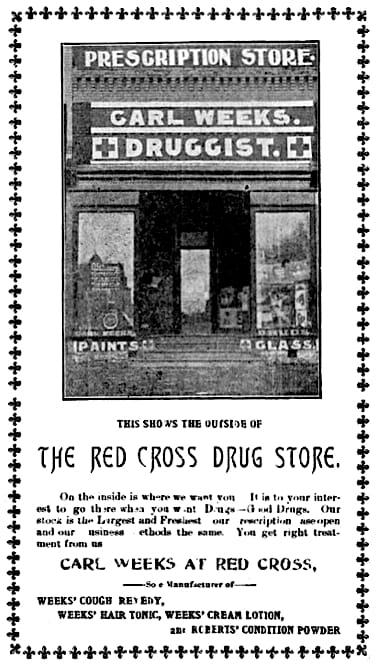
Advertisement for Carl Weeks’ Red Cross Drug Store at 116 East Jackson Street, Centerville.
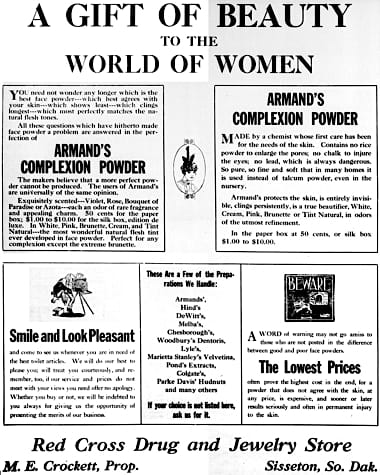
1916 Armand Complexion Powder.
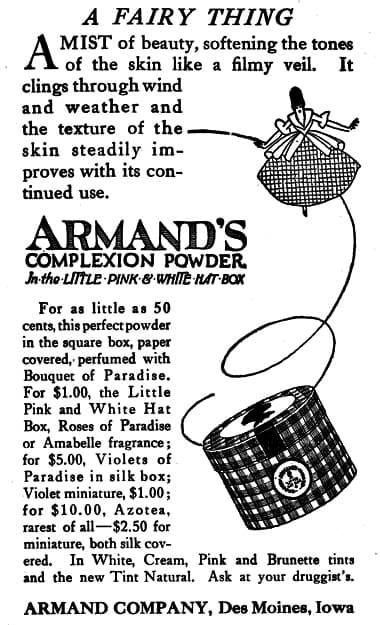
1917 Armand Complexion Powder in a box designed by N. W. Ayer & Sons that came with the following trademarks: Louis XVI silhouette medallion; Armand signature; and a red and white blue stripe pattern .
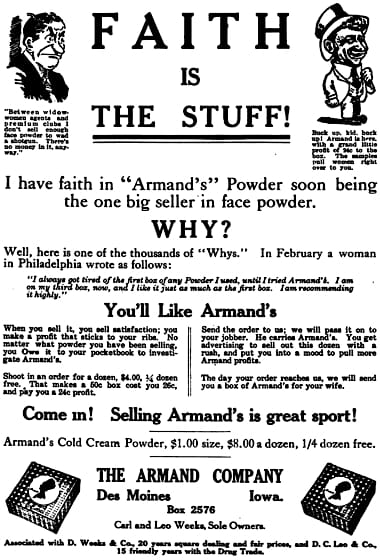
1918 Trade advertisement for Armand Complexion Powder highlighting the company’s links to D. Weeks & Co. and D. C. Leo & Co.
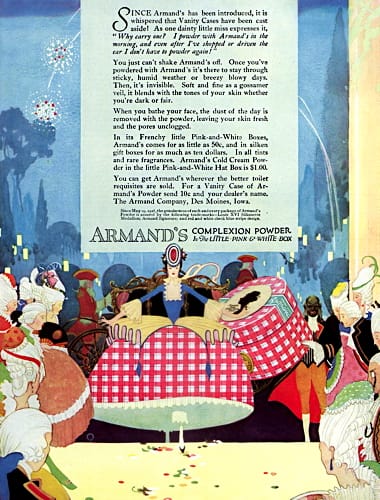
1918 Armand Complexion Powder.
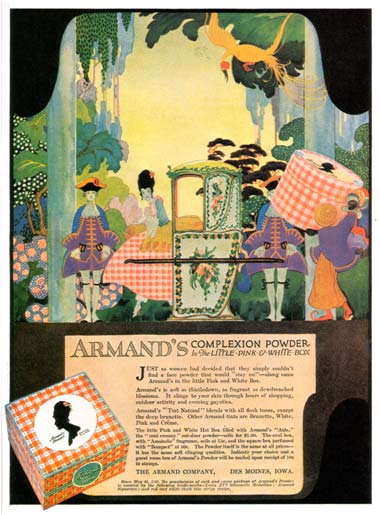
1918 Armand Complexion Powder.

1919 Armand Complexion Powder (Australia).
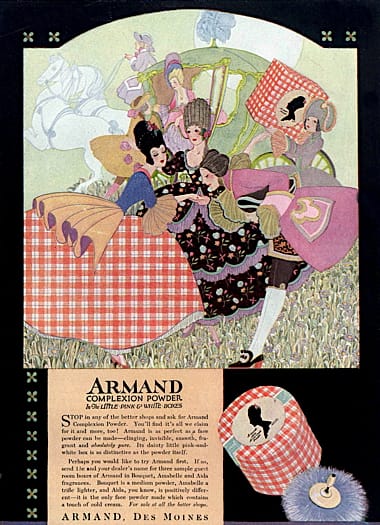
1919 Armand Bouquet, Amabelle and Aida Complexion Powders.
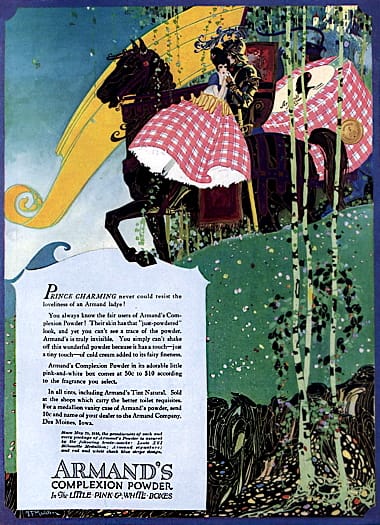
1919 Armand Complexion Powder.
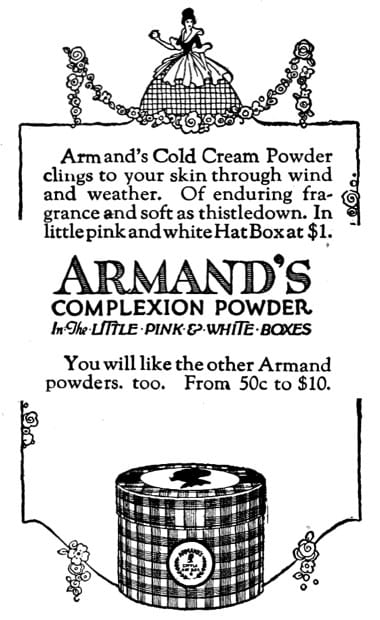
1919 Armand Complexion Powder.
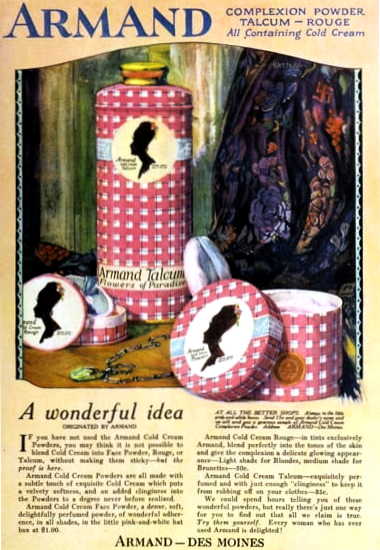
1920 Armand Complexion Powder, Talcum and Rouge.
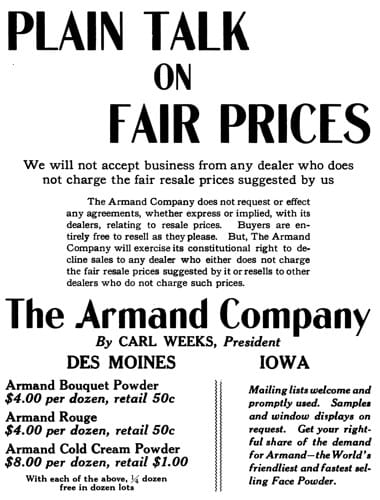
1921 Armand industry advertisement. Plain talk on fair pricing.

1921 Carl Weeks and family. His wife, Edith [1882-1955], and sons: Charles [1908-1991], William [1910-1994], Evert [1912-2002] and Lafayette [1919-1986].
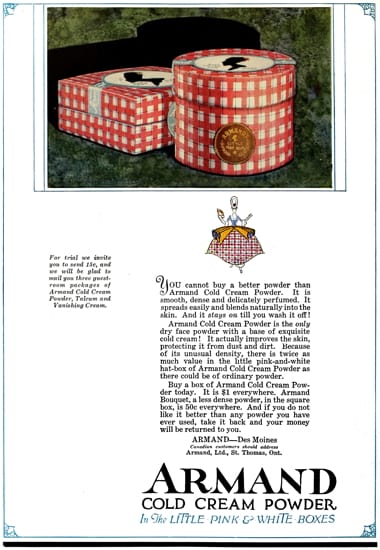
1922 Armand Cold Cream Powder in the classic pink and white checked hat box and Armand Bouquet Powder in the square box. The switch from the prominent Complexion Powder to Cold Cream Powder began in 1920.
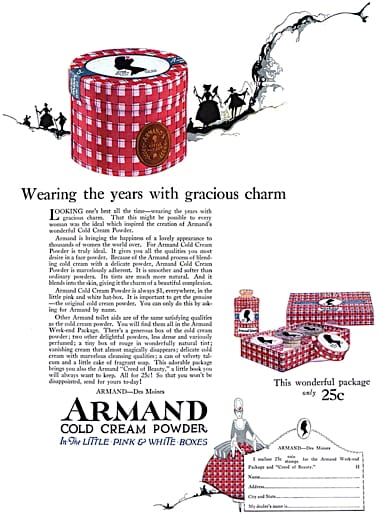
1923 Armand Weekend Package.
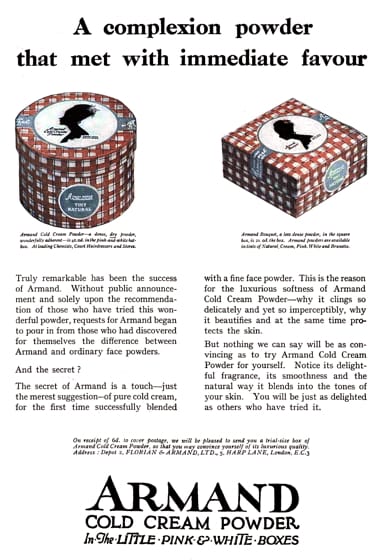
1923 Trade advertisment for Florian & Armand (London).
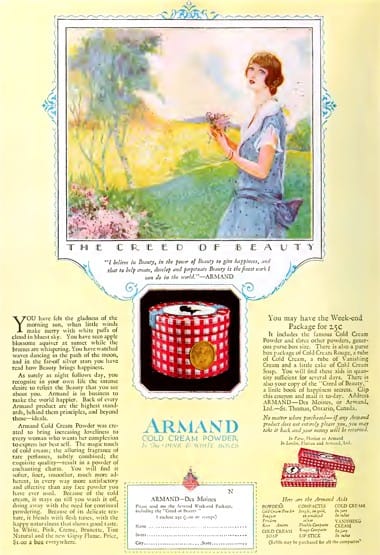
1924 Armand. The Creed of Beauty.
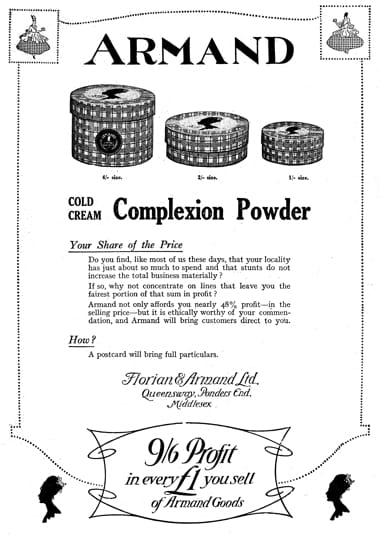
1924 Trade advertisment for Florian & Armand Ltd.
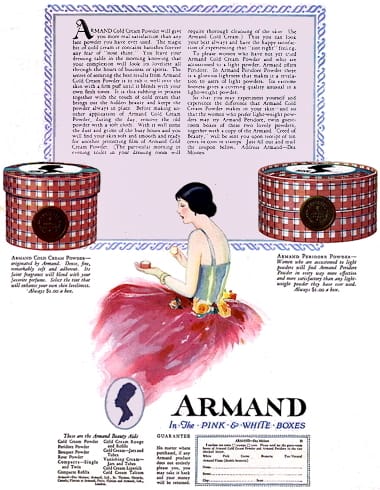
1925 Armand Peridore Powder.

1926 Armand Cold Cream Powder for blondes, brunettes and in-betweens.

1927 Armand Cold Cream Powder.
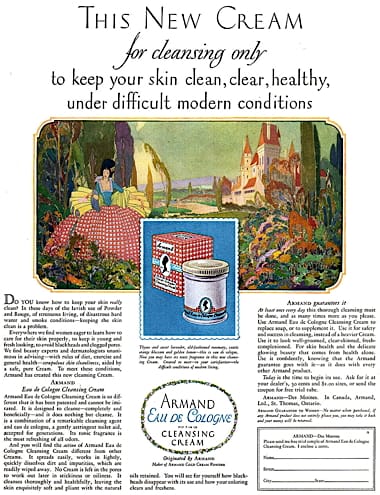
1927 Armand Eau de Cologne Cleansing Cream.
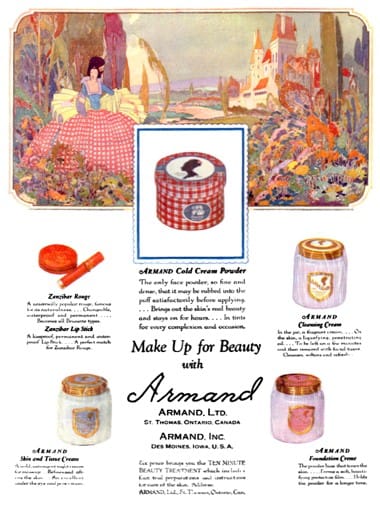
c.1928 Armand Cold Cream Powder, Cleansing Cream, Foundation Cream, Skin and Tissue Cream, Zanzibar Rouge and Zanzibar Lipstick.
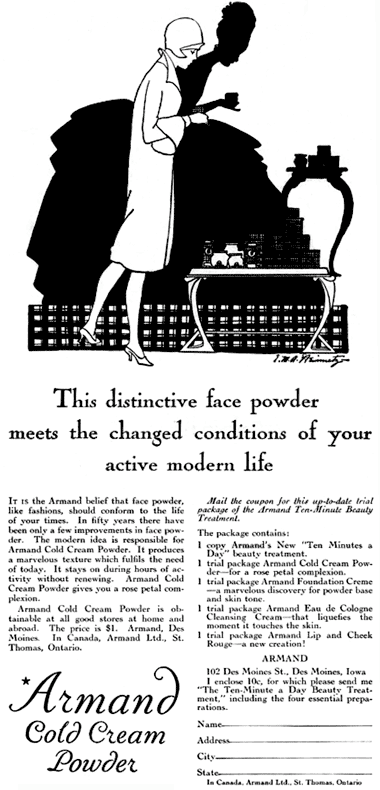
1928 Armand Cold Cream Powder.
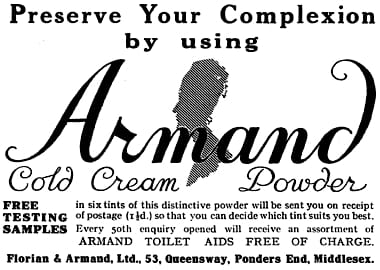
1928 Armand Cold Cream Powder (Britain).
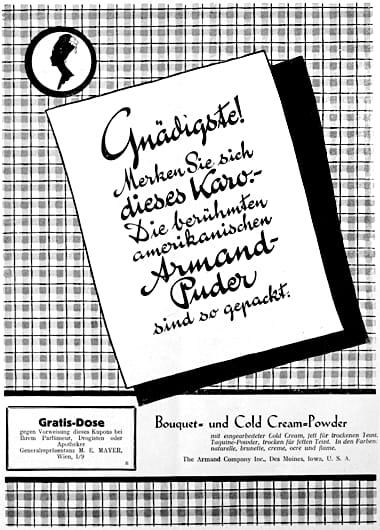
1928 Armand-Puder (Austria).
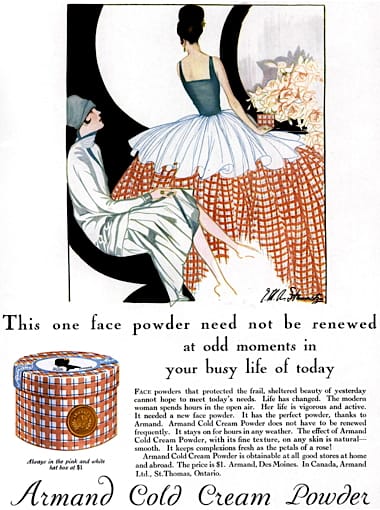
1928 Armand Cold Cream Powder.
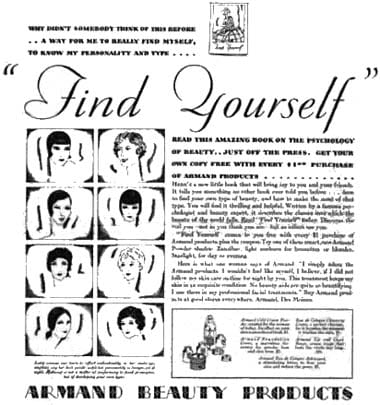
1929 Part of an advertisement for the ‘Find Yourself’ campaign. “Why didn’t somebody think of this before … a way for me to really find myself, to know my personality and type”.
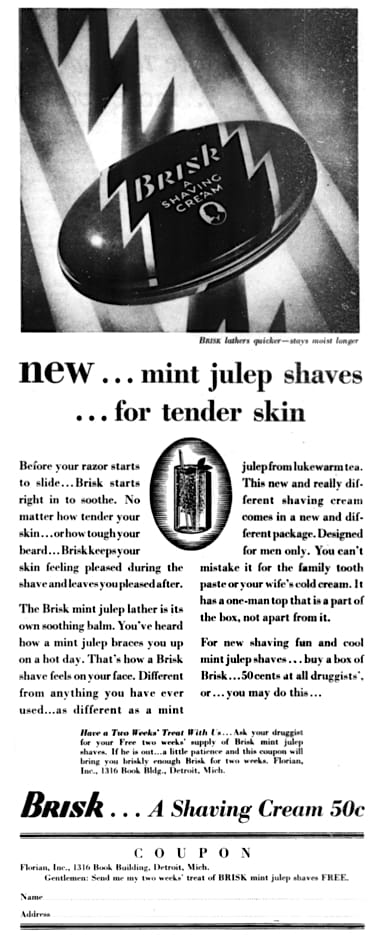
1929 Florian Brisk shaving cream.
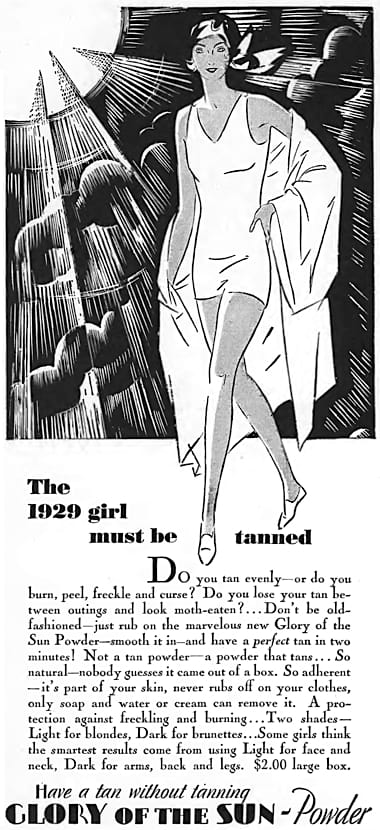
1929 Carlé Glory of the Sun Powder.
